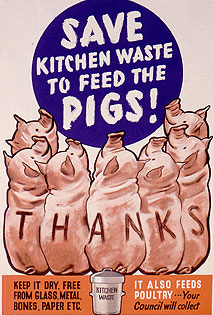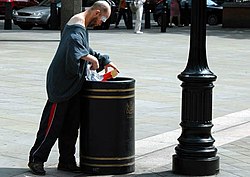Waste in the United Kingdom
It is estimated that 290 million tonnes of waste was produced in the United Kingdom in 2008 but volumes are declining.[1] In 2012 municipal solid waste generation was almost 30 million tonnes, according to Waste Atlas Platform.[2]
The National Waste Strategy is a policy of the government, and in particular the Department for Environment, Food and Rural Affairs (Defra), intended to foster a move to sustainability in waste management within
Food waste

Since 1915,
The main and most common method of disposal in the United Kingdom is landfill. Other methods are also used such as Incineration and anaerobic digestion. Out of all of the waste that was from household, commercial and industrial waste, approximately 57%[3] of the waste was disposed in landfill sites. In addition some waste from sewage sludge, mining waste, and quarrying waste are moved to landfill sites. Landfill has been the most efficient way of disposal in the UK, as of in 1994 there were approximately 4000 landfill sites.[3]
Other types of waste
Household waste
Throughout the country, the average person generates a little over one thousand pounds of waste per year. This average varies city to city-ranging from seven hundred to slightly over thirteen hundred pounds per person a year.[4]
Commercial waste
In the UK, all businesses and other organisations have a legal duty of care over the waste they generate. This legal responsibility was introduced in the groundbreaking Environmental Protection Act (EPA) 1990[5] and was recently amended by the Environment Act (EA) 2021[6] to provide more clarity in definitions and expand responsibilities. The duty of care stipulates that waste generated by non-domestic activities cannot be mingled with the domestic waste stream. Instead, businesses are responsible for the waste they produce until it is recovered of, or disposed of. Most businesses in the UK demonstrate compliance by obtaining a Waste Transfer Note from commercial waste collection providers.[7]
Fly tipping
This is the illegal dumping of waste, most commonly found among roadways or abandon areas, which has been increasing and becoming a problem within parts of the UK. Household items are the most commonly found items among incidents. In 2016 there was around one million fly tipping incidents which was more than a 5% increase from the previous year.[8] Majority of the culprits are individuals who are unwilling to pay or allocate the time to properly dispose of their waste. The most common size load was equivalent to the size of a small work van. These incidents threaten human health as it pollutes the air and harms the environment significantly. It was estimated that the cost of clearance of this waste by officials was over sixty million dollars. Penalties and regulations have become significantly more harsh in order to deal with this issue.[8]
Hazardous waste
This waste is produced mainly from mining and minerals as well as any other unaffiliated oil or oily water. This includes substances such as asbestos, solvents, pesticides, oils etc. They account for the lowest percentage of waste accumulated in the UK, however can be the most harmful if not properly treated and managed.[9]





